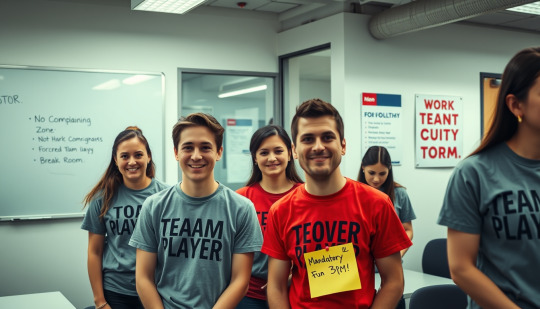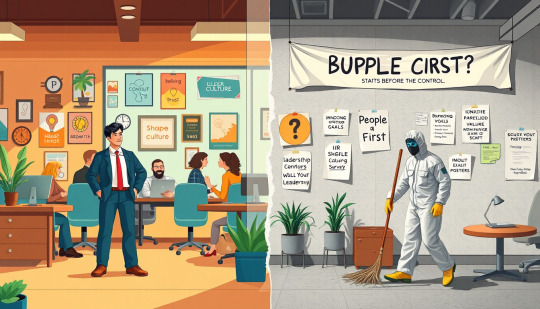Don't wanna be here? Send us removal request.
Text

“Work-Life Integration: The New Reality of Modern Professionals”
Gone are the days of clearly separated work and home life. Today’s professionals often juggle dashboards and diapers in the same breath. This image perfectly captures the delicate dance of productivity and parenting—where deadlines meet baby giggles. As remote work becomes the norm, companies must reimagine employee experience and flexibility. At Sapient HR, we help businesses support working parents, redefine wellness, and craft policies that reflect life’s new rhythms. Because behind every spreadsheet is a real person with a full life.
0 notes
Text
Why Your ‘High-Performance Culture’ Is Burning Everyone Out

Let’s get one thing out of the way: high performance isn’t the enemy.
But the way many companies chase it? That’s the problem.
Somewhere along the line, "high-performance culture" became synonymous with long hours, unspoken expectations, endless urgency, and burnout worn like a badge of honor. And instead of building teams that thrive, many organizations are running their people into the ground—and calling it success.
If your team is exhausted, disengaged, or quietly leaving, it’s time to ask a tough question:
Is your culture actually high-performing—or just high-pressure?
🚩 When “High Performance” Becomes Code for Overwork
It starts innocently enough. A few top performers go above and beyond. They set the bar. Others follow. Eventually, “above and beyond” becomes the new baseline.
Emails at midnight? Normal.
Skipping lunch? A sign of commitment.
Using PTO? Quietly judged.
The culture shifts. Not through policy, but through invisible expectations. Everyone’s pushing harder, faster—and eventually, it breaks them.
And here’s the kicker: burnout doesn’t just affect people—it tanks performance too.
📉 The Cost of a Culture That Never Slows Down
When companies glorify output at all costs, they pay for it in:
Turnover: Top talent doesn’t stick around where exhaustion is the norm.
Creativity loss: Innovation dies when people are too tired to think clearly.
Toxic culture: Fear replaces trust. Micromanagement creeps in. Teams break down.
People might stay quiet, but they’re not okay. They’re not loyal. And they’re not bringing their best selves to work.
💡 Real High Performance Looks Different
If you're aiming for true excellence, here’s the truth:
Burned-out teams don't perform. Balanced teams do.
Here’s what healthy high-performance culture actually looks like in 2025:
1. Clarity Over Chaos
High performers need direction—not just pressure. Clear goals, defined roles, and consistent priorities cut the noise and help people focus where it matters.
2. Rest as a Strategic Tool
Recovery fuels productivity. Encourage time off. Make rest normal, not earned. Some of your best ideas will come from well-rested brains—not overworked ones.
3. Psychological Safety Is Non-Negotiable
People must feel safe to challenge ideas, speak up, and admit mistakes. Performance thrives in trust—not fear.
4. Effort ≠ Value
Stop measuring performance by hours worked. Focus on impact. Give people autonomy to reach outcomes in the way that works for them.
5. Feedback That Actually Helps
Real feedback isn’t just performance reviews once a year. It’s regular, specific, and two-way. It builds people, not just measures them.
🙋♀️ What High Performers Actually Want
Spoiler: it’s not more pizza parties or vague praise.
They want:
Purpose-driven work
Supportive managers
Room to grow
Boundaries that are respected
Recognition that’s meaningful
They want to be seen as humans, not machines.
🔄 The Culture Shift Starts at the Top
No transformation sticks unless leadership buys in.
Executives and managers must:
Model balance (yes, actually take that vacation)
Call out overwork before it becomes culture
Reward effectiveness, not just visibility
When leaders normalize self-care and smart work, the entire organization shifts.
🧠 Final Thought: High Performance Should Feel Good
High performance shouldn’t feel like survival mode.
When done right, it’s energizing, collaborative, sustainable—and even joyful. It brings out the best in people without draining the life out of them.
So if your team is burning out, it's not a talent issue. It's a culture issue.
The good news? You can fix it.
Need help building a performance culture that actually works? SapientHR helps companies design people-first strategies that drive results without the burnout. Because great work shouldn’t come at the cost of well-being.
0 notes
Text

“You Can’t Build Culture with Matching T-Shirts”
Team-building shouldn’t feel like forced fun. When “mandatory joy” replaces meaningful engagement, you don’t get loyalty—you get eye rolls in unison.
Real culture isn’t loud. It’s felt in trust, safety, and how people treat each other when no one’s watching. Not just at 3 PM in matching shirts.
0 notes
Text
HR Isn’t a Department—It’s Your Competitive Advantage (If You Let It Be)

When people think “competitive advantage,” they think product, pricing, marketing—or maybe tech. Rarely does anyone say “HR.” And that’s a mistake.
Because the companies attracting the best talent? The ones retaining it, developing it, and aligning it with the business? They’re not doing it by accident. They have HR that’s strategic, human-centered, and radically aligned with business goals.
🧠 HR Isn’t Just for Hiring and Firing
Traditional HR has been boxed into admin work:
Payroll
Policies
Compliance
Exit interviews
But real HR isn’t about filling seats. It’s about fueling performance. It’s about turning a group of individuals into a unified, purpose-driven team.
Want to scale faster? Avoid toxic culture? Retain your top 10% of talent?
Then you don’t need “HR paperwork.” You need HR leadership.
🚀 When HR Leads, Business Wins
A great onboarding experience? Increases retention by 82%.
Clear performance management? Boosts engagement and output.
Manager coaching? Prevents burnout before it starts.
Career pathing? Keeps future leaders in-house instead of losing them to LinkedIn recruiters.
These aren’t “nice to haves.” They’re profit levers. And HR holds the keys.
🔥 The Catch? You Have to Let HR In
Here’s the uncomfortable truth: In many companies, HR is left out of the strategy room. They’re called in after decisions are made—“Can you help us hire 20 engineers, yesterday?” But if HR isn’t part of the conversation early, you’re solving people problems too late.
When HR is treated like an afterthought, you get:
High attrition
Cultural confusion
Poor leadership development
A team that’s working hard—but not smart
Letting HR sit at the leadership table isn’t a trend. It’s the unlock you didn’t know you needed.
💡 Want to Outperform Your Competitors?
Then stop asking HR to just reduce risk. Start asking how HR can build resilience, unlock innovation, and scale performance.
Make them a partner in:
Growth strategy
Leadership hiring
Culture design
Change management
Because when HR becomes your growth engine—not just your policy monitor—you gain what most companies desperately lack: A people-first advantage that actually drives business outcomes.
Final Thought
HR isn’t a cost center. It’s your most underleveraged growth function.
The question is: Will you keep treating it like a department? Or finally unleash it as your edge?
SapientHR | People. Strategy. Results. →
0 notes
Text

Culture Wall vs. Reality Check
This split-image tells two conflicting HR stories in one frame.
On the left, we see a vibrant office, packed with posters proclaiming values like “Belonging,” “Trust,” and “Shape Culture.” Leaders smile, the mood is bright, and buzzwords fill the walls.
On the right, the illusion unravels. A tired janitor in hazmat gear sweeps beneath chaotic, grammatically incorrect posters like “Bupple Cirst?” and “Peope a First.” The walls are plastered with performative values and vague leadership surveys, revealing the disconnect between stated culture and actual employee experience.
This image asks: Is your company’s culture a lived experience—or just wall décor for visitors?
0 notes
Text
Career Pathing is Broken—And Employees Know It

Let’s drop the act: most companies don’t actually have career paths. They have vague promises, dusty org charts, and the occasional “growth conversation” that goes nowhere.
Employees see through it. And they’re leaving because of it.
🚧 What Career Pathing Should Be A real career path:
Defines skill growth, not just job titles
Includes cross-functional options—not just straight lines
Has actual timelines, not “someday when we see fit”
Aligns employee goals with business needs
But in reality?
Employees are told to “own their career,” which often translates to “figure it out yourself—and try not to ask for a raise.”
👀 What Employees Actually Experience Promotions decided behind closed doors
Managers who can’t answer, “What’s next for me?”
HR frameworks no one’s updated in years
Lateral moves disguised as “growth”
Learning budgets with so many hoops, no one uses them
It’s no wonder employees stop engaging. They realize upward mobility often means leaving.
💡 Why This Hurts You More Than Them Your top talent isn’t waiting around.
They’re building side hustles. They’re interviewing at companies that show a real roadmap. They’re tired of asking for clarity that never comes.
And when they leave, they take hard-won knowledge—and their peers’ trust—with them.
🛠️ What Fixing Career Pathing Really Takes Stop Over-Promising If you can’t map out a promotion timeline, don’t pretend one exists.
Make Career Ladders Transparent Show the skills, the expectations, and the metrics clearly.
Train Managers Most don’t know how to talk career growth because they never had it themselves.
Reward Lateral Growth Too Not everyone wants to manage. Show that specialists matter.
Listen Ask employees how they define career growth. Then build from that.
🎯 Final Thought Career pathing isn’t broken because it’s hard. It’s broken because most companies never prioritized it.
But today’s workforce doesn’t just want a job. They want a journey—with a direction.
👉 Don’t leave your top talent guessing. Let SapientHR help you build career paths that work—for everyone.
0 notes
Text
We’re Not in 2015 Anymore: Why Your Hiring Funnel Is Broken

Remember when hiring meant tossing up a job ad, skimming a few hundred résumés, and picking the top three who “checked the boxes”? That might’ve worked in 2015. But in 2025? That playbook is dead.
Today’s job market is faster, messier, and way more human. Yet too many companies are still clinging to broken hiring funnels built for another era—one that no longer exists.
🚫 The Resume Isn't Telling You What You Think
We’re still screening candidates based on keywords and Ivy League filters, even as we claim to value “skills” and “potential.” Résumés don’t show problem-solving ability, adaptability, or cultural intelligence.
But your ATS doesn’t know that. It’s tossing out great talent because they didn’t use the magic words you copy-pasted from a 2015 job description.
📉 Ghosting Is a Symptom, Not the Problem
Candidates ghost interviews? Don’t be surprised. Your hiring funnel:
Takes too long
Communicates poorly
Makes people jump through hoops without value
Top talent won't tolerate a 6-week process for a mid-level role. They want clarity, speed, and authenticity—not formality and silence.
🧠 Skills-Based Hiring… Just a Buzzword?
Companies love to talk about hiring for skills, not degrees. But most funnels haven’t caught up:
Are you testing real-world ability?
Are you evaluating how people think, not just what they’ve done?
Are hiring managers trained to spot potential over pedigree?
Spoiler: If your entire funnel still filters for “3–5 years of X,” you’re not hiring for skills—you’re hiring for comfort.
⚠️ The Funnel Isn’t Just Outdated—It’s Costing You
A broken hiring process isn’t just inefficient. It’s expensive. Every friction point increases:
Drop-off rates
Bad hires
Candidate resentment (and social media receipts)
Your dream hires don’t finish your application. Your competitors move faster. And your brand takes the hit.
🔧 Fix It Like It’s 2025
Here’s what the modern hiring funnel should look like:
Short, human job descriptions (ditch the buzzwords)
Skills assessments before résumés
Transparent timelines and salary ranges
Two-way interviews, not interrogations
Feedback loops that show respect
It’s not about overhauling everything—it’s about treating candidates like people, not data points.
🚀 Let HR Lead the Way
Modern HR isn’t just about compliance and paperwork. It’s a strategic driver of talent acquisition that actually works.
👉 Partner with SapientHR to rebuild your hiring funnel from the ground up—smarter, faster, and built for the world we live in now.
0 notes
Text
The New Face of Leadership: Empathy, Burnout, and Brutal Honesty

Gone are the days when leadership was all about control, charisma, and corner offices. In 2025, the leaders people actually want to follow look very different: they’re empathetic, transparent, human—and sometimes, brutally honest.
But here’s the catch: leading this way is harder, not easier. And the emotional labor of “being real” is burning out even the best-intentioned leaders.
👂 Empathy Is No Longer Optional
Today’s workforce, especially Gen Z and younger millennials, won’t tolerate old-school top-down leadership. They want to be seen. Heard. Understood.
Empathy is now a core leadership skill, not a “nice to have.” It means:
Making space for mental health
Listening before reacting
Understanding context behind performance
Leading with curiosity, not assumptions
But constantly holding emotional space for others—while trying to hit metrics—is a recipe for exhaustion if there’s no support system.
🔥 Burnout at the Top
Leaders are burning out too, and fast. Why?
They’re expected to be relatable and inspirational…
While managing layoffs, hybrid chaos, and cultural conflict…
All without showing too much “weakness.”
That pressure cooker is pushing many into quiet despair, and HR is often the first to see it—but the last to be heard.
💬 Brutal Honesty is the New Trust Currency
In a world overloaded with corporate speak and performative wellness emails, the one thing employees crave is realness.
When leaders admit:
“We don’t have all the answers.”
“Yes, we’re struggling.”
“This layoff hurts, and here’s why it happened…”
…employees don’t lose trust. They gain it.
Transparency, even when it’s messy or painful, is better than silence or spin.
🚀 Redefining Leadership for the Future
To lead in today’s workplace, you don’t need to be perfect. You need to be:
Human over heroic
Present over polished
Open over omniscient
Empathy without boundaries leads to burnout. Honesty without compassion can be cruel. But together? They form the foundation of the modern, resilient leader.
👣 Where HR Fits In
HR isn’t just here to manage performance. It must now coach, support, and develop this new generation of leaders—leaders who feel everything and still show up.
Want to build leadership that actually works in the real world of work? 👉 Partner with SapientHR — because the future of leadership isn’t soft. It’s real.
0 notes
Text
When Leaders Don’t Listen, HR Becomes the Villain

HR often walks a tightrope. On one hand, it's meant to protect employees, foster culture, and advocate for fairness. On the other, it serves leadership, enforcing business decisions and managing risk. But when executives stop listening, HR gets trapped—and employees start seeing HR not as a resource, but as the enemy.
🎭 The Middleman with No Power
HR professionals are often told, “Bring us feedback!” or “We value transparency!” But when that feedback is uncomfortable—say, about a toxic manager or crumbling morale—it’s too often met with dismissiveness, deflection, or outright denial.
At that point, HR’s job turns into cleaning up messes without the authority to prevent them. Employees see HR delivering the bad news, enforcing the policy, staying silent on leadership failures—and assume HR is complicit.
😶 HR Isn't Broken—The Chain of Command Is
It’s not that HR wants to ignore employee concerns. It’s that when leadership refuses to act or punishes honesty, HR’s hands are tied. And worse, they’re blamed for the very dysfunction they’re trying to fix.
This dynamic erodes trust on every level:
Employees stop reporting problems.
HR stops raising red flags.
Leaders operate in an echo chamber.
And when problems explode? HR takes the fall.
💥 The Cost of Silence at the Top
When leaders don’t listen:
High performers leave.
Toxic behavior spreads.
Psychological safety disappears.
Your employer brand takes a hit.
HR can’t fix what leadership won’t acknowledge. And employees can smell performative leadership a mile away.
🔁 Reset the Dynamic: How Leaders Can Actually Empower HR
If you want an HR team that drives culture and not just compliance, leadership must:
Listen Actively and Consistently Don’t wait for a crisis to ask HR what’s really happening.
Act on Hard Truths When HR brings you uncomfortable feedback—treat it as gold, not insubordination.
Back HR Publicly If you want employees to trust HR, show that you do.
Give HR Strategic Authority Let them sit at the decision-making table, not just the clean-up crew.
🧭 Bottom Line
When leaders don’t listen, HR becomes a scapegoat. But the villain in that story isn’t HR—it’s the leadership culture that silences truth and punishes feedback.
Want HR to be a trusted force for change, not a feared enforcer? 👉 Work with SapientHR — We help leaders build people strategies that actually listen.
0 notes
Text
When Leaders Don’t Listen, HR Becomes the Villain

HR often walks a tightrope. On one hand, it's meant to protect employees, foster culture, and advocate for fairness. On the other, it serves leadership, enforcing business decisions and managing risk. But when executives stop listening, HR gets trapped—and employees start seeing HR not as a resource, but as the enemy.
🎭 The Middleman with No Power
HR professionals are often told, “Bring us feedback!” or “We value transparency!” But when that feedback is uncomfortable—say, about a toxic manager or crumbling morale—it’s too often met with dismissiveness, deflection, or outright denial.
At that point, HR’s job turns into cleaning up messes without the authority to prevent them. Employees see HR delivering the bad news, enforcing the policy, staying silent on leadership failures—and assume HR is complicit.
😶 HR Isn't Broken—The Chain of Command Is
It’s not that HR wants to ignore employee concerns. It’s that when leadership refuses to act or punishes honesty, HR’s hands are tied. And worse, they’re blamed for the very dysfunction they’re trying to fix.
This dynamic erodes trust on every level:
Employees stop reporting problems.
HR stops raising red flags.
Leaders operate in an echo chamber.
And when problems explode? HR takes the fall.
💥 The Cost of Silence at the Top
When leaders don’t listen:
High performers leave.
Toxic behavior spreads.
Psychological safety disappears.
Your employer brand takes a hit.
HR can’t fix what leadership won’t acknowledge. And employees can smell performative leadership a mile away.
🔁 Reset the Dynamic: How Leaders Can Actually Empower HR
If you want an HR team that drives culture and not just compliance, leadership must:
Listen Actively and Consistently Don’t wait for a crisis to ask HR what’s really happening.
Act on Hard Truths When HR brings you uncomfortable feedback—treat it as gold, not insubordination.
Back HR Publicly If you want employees to trust HR, show that you do.
Give HR Strategic Authority Let them sit at the decision-making table, not just the clean-up crew.
🧭 Bottom Line
When leaders don’t listen, HR becomes a scapegoat. But the villain in that story isn’t HR—it’s the leadership culture that silences truth and punishes feedback.
Want HR to be a trusted force for change, not a feared enforcer? 👉 Work with SapientHR — We help leaders build people strategies that actually listen.
0 notes
Text
Remote Work is Here to Stay—But Your Management Style Isn’t

For years, managers relied on walk-bys, open offices, and in-person meetings to lead their teams. But now, the office is virtual, and leadership hasn’t caught up.
Remote work isn’t just a change in location—it’s a shift in mindset.
And many managers? They’re still trying to lead like it's 2019.
📍 Micromanagement Doesn’t Work Without a Desk
In the physical office, micromanagement could pass as “being hands-on.” But remotely? It becomes surveillance—daily check-ins, mouse-tracking, “green dot” policing.
This creates a culture of mistrust, not performance.
Employees don’t need babysitting—they need clear expectations, real autonomy, and accountability based on outcomes, not screen time.
📍 Visibility ≠ Value
One of the biggest remote myths? That the most vocal or most online employees are the most productive.
But in remote work, output > optics.
If your performance reviews are still based on who speaks up most in Zoom calls, you’re rewarding noise, not results. That’s not leadership—it’s laziness disguised as loyalty.
📍 Communication Fatigue Is Real
More meetings don’t equal more clarity. In fact, they often mean less thinking time, more burnout, and decision paralysis.
Remote managers need to master asynchronous communication—clear docs, shared notes, and tools that let people collaborate without burning hours in back-to-back video calls.
📍 The Best Remote Teams Aren’t “Managed”—They’re Enabled
High-performing distributed teams don’t need control. They need:
Clear goals and role clarity
Trust in how they get work done
Access to tools, feedback, and recognition
Psychological safety to raise issues, pitch ideas, or admit blockers
Managers who embrace a coaching style—rather than command-and-control—build teams that self-manage and scale.
📍 Culture Is No Longer in the Office Walls
You can’t rely on happy hours and breakroom snacks anymore. Remote culture is intentional—or it doesn’t exist.
Strong remote managers create culture through:
Regular 1:1s that go beyond task updates
Celebrating wins (big and small) publicly
Leading with transparency and empathy
Making room for off-topic, human connection—yes, even via Slack
💡 Remote Work Isn’t the Problem—Old Leadership Is
If your remote team is disengaged, it’s not because of remote work. It’s because your leadership model never evolved.
Remote work didn’t remove your control. It exposed whether you were really leading—or just watching people work.
Final Thought: Remote Work Is Permanent. Your Playbook Shouldn’t Be.
The future of work demands a new kind of leader—one who trusts, communicates with purpose, and empowers people to thrive from anywhere.
Old-school management won’t survive a remote-first world.
Want to upgrade your leadership strategy for the new world of work? Visit SapientHR to learn how to build remote-ready management systems that actually work.
0 notes
Text
Hiring in 2025: Skills Over Resumes or Just a Trendy Lie?

If you scroll through LinkedIn long enough, you’ll start to believe one thing: “Skills-first hiring is the future.”
No more degrees, no more rigid job titles—just real capabilities.
It sounds great. Inclusive. Modern. Fair. But here’s the real question HR leaders need to ask: Is skills-based hiring truly changing how we hire—or is it just a shiny new wrapper on the same old system?
🚨 The Promise: Skills Over Pedigree
The skills-first movement says:
“We don’t care where you learned it—if you can do it, you’re hired.”
In theory, this levels the playing field. No Ivy League degree? No problem. Bootcamp grad with GitHub receipts? Come on in.
It’s supposed to remove bias, attract overlooked talent, and fill roles faster in a skills-short economy. But...
⚠️ The Reality: Still Stuck on Resumes
In practice, most companies haven’t moved past traditional filters. Hiring software still scans for keywords. Recruiters still screen for schools and titles. Skills-based assessments are rare—and when they do exist, they’re often time-consuming and unpaid, subtly penalizing the very people they’re meant to uplift.
The truth? Skills-first hiring hasn’t scaled. It’s marketing spin—because the systems haven’t caught up.
❌ Where It Goes Wrong
Bias still creeps in: Even when skills are “measured,” who gets chosen often reflects the same old networks and biases.
Assessment overload: Candidates are asked to prove skills in lengthy tests—but only a select few get real feedback or compensation.
Mismatch between HR and hiring managers: Recruiters might embrace skills-first hiring, but hiring managers still default to resumes and “culture fit.”
No infrastructure: Few companies have internal systems to assess, track, and promote skills-based hiring at scale.
✅ What Real Skills-Based Hiring Looks Like
Transparent criteria: Define what success looks like in terms of outcomes, not buzzwords.
Project-based evaluation: Replace multiple interview rounds with one paid work simulation or real-world task.
Blind hiring stages: Evaluate assignments before viewing names, schools, or photos.
Internal mobility: Start with your current employees. Let them move based on what they can do, not just where they’ve been.
💡 Don’t Just Talk Skills—Back It With Process
If you say you value skills over pedigree, prove it:
Ditch degree requirements unless absolutely necessary
Train hiring managers on assessing capability, not charisma
Build interview questions around real scenarios, not hypotheticals
Audit who you’re hiring—and who’s getting left out
Final Thought: It’s Not a Trend—Unless You Treat It Like One
Skills-first hiring could unlock a broader, more dynamic workforce. But only if it’s more than a buzzword.
Otherwise? It’s just resume bias with a better slogan.
Want to make real skills-first hiring work at scale? SapientHR helps companies build hiring systems that prioritize talent—not just titles.
0 notes
Text
From Policy to Culture: Why Your DEI Strategy Isn't Working

In recent years, companies have been quick to roll out Diversity, Equity, and Inclusion (DEI) initiatives—publishing polished statements, hiring heads of DEI, and hosting mandatory workshops. But despite all the effort, real inclusion still feels like a checkbox. Employees nod politely, HR tracks attendance, and nothing actually changes.
Why? Because policy without culture is just lip service.
1. DEI Has Become a Buzzword—Not a Belief
Too many DEI programs focus on optics over impact. A new policy here, a training module there—but without true leadership buy-in or structural change, these efforts come across as performative. People can feel when inclusion is a tactic, not a value.
DEI isn’t a one-day seminar. It’s a long-term mindset that has to be woven into how a company hires, promotes, listens, and leads.
2. Your Leadership Doesn’t Reflect Your Values
If your DEI committee is diverse, but your C-suite isn’t, the message is clear: diversity is good—just not at the top.
Representation isn’t just about who’s in the room. It’s about who gets to make decisions. If your leadership team isn’t diverse in identity and perspective, your DEI strategy is stalled at the starting line.
3. Tokenism Is Undermining Trust
DEI fails when it becomes about headcounts, not people. Hiring a few individuals from underrepresented backgrounds, then spotlighting them in every brochure, only reinforces the feeling of being “the only one.”
True inclusion means creating safe, equitable systems—not just showcasing diversity when it’s convenient.
4. Your Culture Still Punishes Dissent
If employees don’t feel comfortable speaking up—about microaggressions, unfairness, or exclusionary behavior—your DEI policy is meaningless.
Psychological safety is the foundation of inclusive culture. If feedback leads to retaliation or silence, people will disengage, no matter how inclusive your policies look on paper.
5. One-Off Training Doesn’t Change Behavior
Unconscious bias training is a start, not a solution. One workshop doesn’t rewire systems built over decades. Without follow-up, accountability, or leadership modeling inclusive behavior, training becomes a forgotten calendar invite.
Culture changes when behaviors change—consistently, visibly, and from the top down.
What Real DEI Looks Like
✅ Clear accountability: DEI metrics tied to manager performance ✅ Shared leadership: Diverse hiring panels, mentorship, and succession planning ✅ Transparent processes: Pay equity audits, promotion tracking ✅ Inclusive rituals: Meetings, feedback loops, benefits, and celebrations that reflect everyone—not just the majority
Final Thought: DEI Isn’t a Department. It’s a Lens.
You don’t “do” DEI once a year. You live it. Every policy, meeting, job posting, and performance review is a chance to either include or exclude.
DEI becomes culture when it’s everyone’s job, not just HR’s.
Ready to go beyond checkboxes and build real inclusion into your company’s DNA? Visit SapientHR to rethink your DEI strategy from the ground up—with systems that reflect the culture you actually want.
0 notes
Text
The TikTok Effect: When HR Policies Get Canceled

It used to be that a company policy lived and died within the walls of HR. You wrote the handbook, distributed the PDF, maybe ran a training session—and that was that. But today? One frustrated employee, a smartphone, and a 30-second TikTok video can undo months of HR work in a matter of hours.
Welcome to the TikTok Effect: where HR policies are no longer just internal documents, they’re subject to the court of public opinion—and that court is fast, brutal, and viral.
When HR Goes Viral for the Wrong Reasons If you’ve spent time on TikTok, you’ve probably seen them:
An employee crying in their car after being fired “for no reason”
Screenshots of dress code policies that feel outdated or discriminatory
Sarcastic skits mocking DEI training that feels performative
Exposés of HR’s response to harassment complaints
Sometimes, the videos rack up millions of views before the company even realizes it's been named. And just like that, a carefully crafted HR policy becomes a PR disaster.
The issue isn’t just bad optics—it’s that HR teams haven’t caught up to the reality that every policy is now public-facing.
Why This is Happening There are a few forces at play here:
Gen Z is radically transparent. This generation has grown up online, documenting everything from mental health struggles to work grievances. They don’t separate their personal and professional selves—and they don’t think twice about sharing an injustice if it might help others.
“Corporate cringe” content performs. TikTok rewards content that’s emotional, ironic, or rage-inducing. HR policies that seem tone-deaf or punitive are perfect fodder.
Employees don’t feel heard internally. When internal complaints go ignored or minimized, employees turn to platforms where they will be heard—and where others will validate their experience.
The Real Risk: Loss of Trust Going viral is bad. But the erosion of trust is worse.
Once a policy becomes the subject of mockery or outrage online, it’s nearly impossible to enforce it without pushback. Employees start to view HR as out of touch—or worse, antagonistic.
This can affect:
Recruitment: Talented candidates will ghost interviews or rescind offers after a viral scandal.
Retention: Employees may disengage or quietly leave toxic environments.
Brand reputation: Customers care about how you treat your people.
HR Can’t Be “Just HR” Anymore Modern HR must think like a brand manager. Every policy is a communication strategy. Every training is content. Every email could be screenshotted.
That doesn’t mean you need to fear your employees. It means you need to design policies with empathy, transparency, and credibility—as if the whole world might see them. Because they might.
How to Future-Proof Your HR Policies Here’s how smart HR teams are adapting:
Pressure-test policies before rollout. Ask: If this ended up on TikTok, would we be proud of it? Bring in employee focus groups before rollout. Get honest feedback.
Write like a human, not a lawyer. Tone matters. If your policy reads like a cold rulebook, it’ll feel adversarial. Use plain, respectful language that communicates intent, not just rules.
Be prepared to respond publicly. Have a rapid response plan. If something goes viral, acknowledge it. Don’t hide behind “we don’t comment on internal matters.” That silence can be louder than outrage.
Empower managers to own the message. Frontline managers are your first line of defense. Train them to explain policies with compassion—and to flag potential issues before they hit the internet.
Use the TikTok Effect as a Wake-Up Call The goal isn’t to police employee behavior online. The goal is to build an internal culture so trustworthy that employees don’t feel the need to go public in the first place.
If employees feel respected, heard, and supported, they’ll be your best brand advocates—not your most viral critics.
Final Thoughts The TikTok Effect is real—and it’s not going away. But instead of fearing it, HR can leverage it. Let it be a mirror, showing you what’s broken and what needs to evolve.
Policies aren’t just about compliance anymore. They’re about culture. And if you’re not writing them with that in mind, someone else will rewrite them for you—in 30 seconds or less.
Want help crafting HR strategies that resonate with today’s workforce? Check out SapientHR—where we turn policy into culture.
0 notes
Text
Neurodivergent Layoffs: Why Autism Hiring Initiatives Are Failing

Over the past decade, companies have proudly launched autism hiring initiatives. You’ve seen the headlines: “We’re building a neurodiverse workforce.” “We support talent, not labels.” “Different brains, same brilliance.”
And yet, behind the PR glow, a quiet backpedal is underway. As economic pressures mount and layoffs spread across industries, neurodivergent employees are often the first to go—despite all the promises.
So what went wrong?
The Rise of Autism Hiring Programs Around 2015, tech and finance companies began piloting specialized hiring tracks for autistic candidates. The idea was revolutionary: reframe neurodivergence as a strength, not a liability. Focus on skills, not social polish. Redesign interviews. Provide job coaches. Normalize workplace accommodations.
At first, it worked. Employers gained talented analysts, coders, designers, and quality testers—many of whom thrived in focused, detail-oriented roles.
But now, many of those programs are being quietly paused, downsized, or absorbed into broader DEI statements. The language remains inclusive, but the infrastructure has vanished.
The Reality Behind the Rhetoric Hiring neurodivergent talent is easy to market. Retaining and supporting that talent long-term? That’s where companies start to pull back.
Why?
Accommodations weren’t embedded—just bolted on. Many companies created autism hiring programs as siloed side projects. But without integrating support across teams and managers, those programs became fragile—dependent on one HR lead or a single budget cycle.
Layoffs aren’t neutral—they’re biased. When layoffs hit, neurodivergent employees often appear “less collaborative” or “harder to manage” in internal reviews—not because of poor performance, but because they don’t fit traditional communication norms. Bias creeps in.
Success wasn’t scaled. Once the pilot programs proved successful, companies rarely expanded them into mainstream hiring. Instead, they treated it as “special hiring,” which made neurodivergent employees feel othered—and expendable.
The Layoff Patterns No One Wants to Admit In tech, finance, and even HR, there’s a pattern emerging:
Neurodivergent hires are not rehired after restructures.
Managers avoid “high-touch” employees who require more coaching.
Performance review rubrics penalize behaviors unrelated to job output (like “team fit” or “engagement in social events”).
And because most autism hiring initiatives lack leadership advocacy, they quietly disappear when budgets get tight.
This isn’t just a missed opportunity. It’s a betrayal.
The Psychological Toll For many neurodivergent professionals, getting hired through a targeted program was life-changing. It was the first time they felt seen, welcomed, and valued. Being laid off—or worse, reassigned without support—undermines not just their career, but their trust.
The impact includes:
Heightened anxiety and burnout
Difficulty re-entering traditional hiring pipelines
Lingering stigma of being “the DEI hire” who didn’t work out
These aren’t just individual failures—they’re systemic design flaws.
What HR and Leadership Must Do Differently If companies truly care about neurodiversity, they can’t treat it as a side campaign. It must be embedded into culture, policy, and performance frameworks.
Here’s how to start:
Redesign performance reviews. Strip out vague metrics like “culture fit.” Focus on outcomes. Train managers to recognize communication differences without penalizing them.
Protect accommodations during restructures. Make it clear that neurodivergent employees are not “costlier” or “harder to retain.” Set a higher bar for laying off those hired through inclusion programs.
Elevate neurodivergence beyond HR. If your entire neurodiversity strategy lives under DEI or HR, it’s not sustainable. Senior leadership must own it and invest in it.
Don’t pilot—scale. Stop treating neurodivergent hiring as an experiment. Move it into core hiring pipelines. Make it the norm, not the exception.
The Bottom Line Autism hiring initiatives aren’t failing because neurodivergent people can’t succeed. They’re failing because companies never built the systems to support them at scale—and never protected those systems when times got hard.
Inclusion isn’t measured by who you hire when business is good. It’s measured by who you keep when it's not.
Looking to create an inclusive, resilient workforce that actually delivers? Let SapientHR help you build strategies that work for every brain in the room.
0 notes
Text
Quiet Hiring: The Secret Alternative to Layoffs

In the middle of mass layoffs and hiring freezes, a quieter workforce shift is happening—without headlines, without pink slips. It’s called quiet hiring, and it’s changing how companies manage talent, fill gaps, and cut costs without formal layoffs.
But here’s the catch: it may solve short-term problems while creating long-term resentment.
What Is Quiet Hiring? Quiet hiring happens when companies redeploy existing employees into new roles instead of hiring externally. It can look like:
Asking employees to take on more responsibilities
Moving workers to higher-priority projects or departments
Backfilling open roles internally, even if it means shifting job scopes
It’s a talent strategy dressed in survival mode. Instead of losing people, companies reassign them. The upside? They keep headcount stable. The downside? Employees often get more work—without more pay.
Why It’s Becoming So Popular In uncertain economies, companies are under pressure to:
Avoid negative press from layoffs
Save on costs without hiring freezes
Keep operations running despite leaner teams
Enter quiet hiring. It offers flexibility. It’s discreet. It sidesteps the trauma of layoffs and the expense of onboarding.
Some companies frame it as “agility” or “career growth.” But let’s be honest—most employees don’t see it that way.
The Hidden Toll on Employees While leaders may see quiet hiring as a smart pivot, employees often experience it as:
Scope creep: You're still a project manager—but now you’re also leading marketing.
No clarity: Your title and salary stay the same, but expectations explode.
Burnout risk: You're doing 1.5x the work, with zero recognition.
And because the shift is quiet—often informal—there’s no promotion, no raise, no roadmap. Just more work.
The result? Growing resentment and disengagement. Some employees feel they’re being “quietly punished” for being competent.
When Quiet Hiring Works (and When It Doesn’t) Quiet hiring isn’t always bad. In fact, when done with transparency and support, it can be a great way to help employees grow and reduce dependency on external hiring.
Here’s when it works:
✅ You clearly communicate the change ✅ You offer skill-building or development resources ✅ You tie the new responsibilities to future opportunities or promotions
And when it doesn’t?
❌ You dump extra work with no explanation ❌ You treat it as a permanent fix for broken hiring ❌ You ignore employee feedback or burnout signs
If it feels like a bait-and-switch to your team, it probably is.
What HR Needs to Watch Out For As quiet hiring rises, HR teams need to get proactive. That means:
Track role changes, even informal ones. If someone’s doing more, it should be visible—especially during performance reviews or compensation planning.
Protect against burnout. More work without more support is a recipe for disengagement and attrition.
Rethink how you talk about growth. If quiet hiring is part of your talent strategy, reframe it as upskilling with guardrails—not a cost-cutting workaround.
Don’t forget DEI. Quiet hiring often rewards the most visible or outspoken employees. This can unintentionally hurt diversity and equity if not managed carefully.
The Bottom Line Quiet hiring is not inherently a bad practice. In fact, it might be the only realistic option for lean, fast-moving teams during economic uncertainty. But it has to be done intentionally, not quietly.
Because if employees feel like they’re being stretched without reward—or maneuvered into roles they didn’t choose—you’re not “quietly hiring.” You’re quietly losing trust.
Want to build a people-first talent strategy that balances agility and ethics?
👉 Talk to SapientHR—we help businesses rethink hiring, retention, and employee engagement for today’s reality.
0 notes
Text
Hiring Mistakes That Cost You Big—And How HR Can Prevent Them

Hiring Mistakes That Cost You Big—And How HR Can Prevent Them Hiring is one of the most expensive decisions a business makes—and yet, it’s where many companies still cut corners, move too fast, or lean on outdated instincts.
From bad cultural fits to turnover six months in, hiring mistakes don’t just hurt your budget. They impact morale, team performance, and your company’s reputation. And in 2025, with hybrid teams, remote-first roles, and skills-based hiring becoming the norm, the cost of a bad hire has only gone up.
So, what are the hiring missteps companies keep making—and how can HR step in to stop the bleeding before it starts?
Let’s dig in.
Hiring for Skill, Firing for Fit One of the most common (and costly) hiring mistakes is choosing someone just because they look perfect on paper.
They’ve got the degrees. The portfolio. The keywords.
But two months in? They're clashing with teammates, questioning leadership decisions, or just… not fitting the culture.
HR fix: Start treating culture fit as important as skill. Better yet—hire for culture add. Instead of replicating what you already have, look for values alignment, communication style, and adaptability.
Use behavioral interviews. Include team members in the process. Ask about how they’ve navigated conflict or feedback before.
Because soft skills = strong teams.
Rushing to Fill the Role The team is stretched thin. Leadership is breathing down your neck. A key person quit unexpectedly.
You panic. You rush. You hire the first decent option who makes it past two rounds.
And then? It backfires.
HR fix: Build talent pipelines before you’re desperate. HR should partner with marketing to keep a bench of warm candidates. Use internal mobility more strategically—sometimes, the best hire is already on your team.
And don’t forget to communicate timelines clearly. A rushed hire might save a week now, but cost you months of recovery later.
One-Size-Fits-All Interviews Too many companies use a cookie-cutter interview process for every role—same questions, same panel, same format. That may seem efficient, but it often leads to mismatched expectations or missed red flags.
HR fix: Design interview processes that reflect the role’s actual challenges.
For creative roles, include portfolio reviews or real-world scenarios.
For leadership roles, prioritize storytelling, coaching style, and team-building discussions.
For remote positions, assess communication habits, time management, and digital collaboration.
Customize the journey. Don’t just go through the motions.
Ghosting and Poor Communication It’s 2025, and candidates talk—a lot. Ghosting candidates or leaving them in the dark not only damages your brand, it makes great talent walk away before you even make an offer.
HR fix: Implement structured communication checkpoints. Automate updates with a human tone. Even a quick, “We’re still reviewing—thanks for your patience!” goes a long way.
Treat candidates like customers—because some of them are. And all of them talk to others.
Ignoring DEI in the Hiring Funnel If your pipeline lacks diversity, your talent pool—and your business outcomes—will suffer. Hiring from the same networks and schools, with the same biases baked into job ads or interviews, leads to homogenous teams that lack perspective.
HR fix: Audit every step of your hiring process for bias:
Job descriptions: Avoid gendered language or unnecessary “requirements.”
Resume screening: Use blind review tools or structured scorecards.
Panel diversity: Ensure candidates are interviewed by a cross-section of your company—not just senior leadership.
DEI isn’t a checkbox—it’s a business imperative.
No Structured Onboarding Plan A great hire can still fail if they’re thrown into chaos with no real onboarding. Without a clear path, expectations, and support, even the best talent will question their decision to join.
HR fix: HR should lead onboarding with intention:
Create 30/60/90 day plans.
Assign buddies or mentors.
Schedule regular feedback check-ins.
First impressions last—and poor onboarding often leads to early exits.
Final Thought: HR Is the Hiring Gatekeeper—and the Growth Catalyst Every bad hire has ripple effects. It’s not just about one person—it’s about what it does to your team, your morale, and your momentum.
That’s why HR can’t be passive in the hiring process. It must be proactive, strategic, and people-centered.
Because great hiring doesn’t happen by luck. It happens by design.
👉 At SapientHR, we help companies build smarter, more inclusive hiring strategies that don’t just fill seats—they drive success. Let’s rethink how you hire—before the next costly mistake.
0 notes